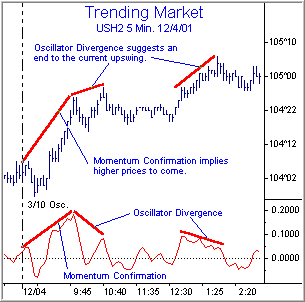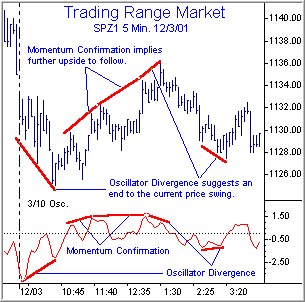
HOT TOPICS LIST
- MACD
- Fibonacci
- RSI
- Gann
- ADXR
- Stochastics
- Volume
- Triangles
- Futures
- Cycles
- Volatility
- ZIGZAG
- MESA
- Retracement
- Aroon
INDICATORS LIST
LIST OF TOPICS
PRINT THIS ARTICLE
by Bob Hunt
Here are a few techniques that I have found to be consistently helpful in capturing intraday profits. Part 1 will discuss oscillator divergence/momentum confirmation.
Position: N/A
Bob Hunt
Creator of the Pattern Trapper On-Line Trading Course and editor of The Pattern Trapper Commodities Newsletter.
PRINT THIS ARTICLE
DAY TRADING
Technical Tools For Day Traders, Part 1
06/06/02 06:04:11 PMby Bob Hunt
Here are a few techniques that I have found to be consistently helpful in capturing intraday profits. Part 1 will discuss oscillator divergence/momentum confirmation.
Position: N/A
| Technical analysis can be defined as the study of past price behavior in an effort to determine future patterns and trends. In this school of thought you assume human behavior is repetitive in nature, but at the same time their behavioral patterns do not normally express themselves in the exact, mechanical manner each time. Even with this qualification in mind, technical analysis can forecast prices with an improved probability of outcome. It can help you achieve the "edge" required for long-term consistent success. A wide array of technical approaches is available. Some are better suited to particular personalities and styles of trading than others. This article will focus on just a few that I have found to be consistently helpful in interpreting intraday market behavior and making short-term price forecasts. My trading time frame of choice is intraday, primarily because of the greater degree of immediate feedback. An important element for consistent success is the ability to quickly realize your mistakes. Technical analysis should tell you what has happened in the past, but it makes absolutely no guarantees about the future, so intraday trading offers a way to "have your finger on the button," ready to take quick action should your market judgements prove incorrect. |
| Oscillator Divergence/Momentum Confirmation Day trading requires futures traders to make constant assessment as to whether a market is in a trending or trading-range mode. If the mode is determined to be trading-range, they need a convenient means of identifying short-term reversal points. On the other hand, if the mode is assumed to be trending, they need to identify an appropriate entry point based on the trend currently in force, and an appropriate exit point based on likely trend exhaustion. One way to identify a short-term intraday market turning point is to evaluate the momentum behind successive market swings. Price momentum is the measure of the rate, or speed, of price change. Normally, if you expect successive market swings to continue creating new highs or new lows, you would expect the rate of price change to increase along with the move to new highs or new lows. If successive swings do not have an increase in momentum, the validity of any new push higher or lower becomes questionable. One effective tool for measuring price momentum is the 3/10 Oscillator. It is a simple indicator constructed by subtracting the 10-period exponential moving average (EMA) from the three-period EMA. As an alternative, most charting packages contain the MACD indicator (moving average convergence/divergence). The 3/10 Oscillator can be simulated using the MACD by setting the short-term parameter to three, the long-term parameter to 10, and the smoothing parameter to one. When using the 3/10 Oscillator, you are attempting to identify one of two conditions on successive market swings that move to either new highs or lows. The first of these conditions is the "oscillator divergence" and the second the "momentum confirmation." The two terms describe opposite conditions. Typically, each successively greater swing pivot high, or swing pivot low, will be accompanied by one or the other. In a market trending towards lower prices, oscillator divergence is described as a swing to new lows in price, accompanied by a higher low in the oscillator. In a market moving towards higher prices, it is a swing to new highs in price, accompanied by a lower high in the oscillator. Examples of both conditions are shown in the charts below.  |

|
| Figure 1: 3/10 Oscillator Divergence/Momentum Confirmation. A trending market is shown on the 5-minute chart of the US Treasury Bond, March 2002, and a trading range is illustrated on a 5-minute chart of the S&P 500, December 2001 contracts. |
| Graphic provided by: TradeStation. |
| |
| In essence, oscillator divergence indicates whether the current market is losing momentum. At these times a reversal is most likely. If you had been considering a trade in the direction of the expected reversal, this would be an opportune time to enter. On the other hand, when momentum confirmation occurs, you know that the current swing direction has some "oomph" left to it, and it would be best to either stay with existing positions or look for an opportunity to climb on board. |
| When properly used, the 3/10 Oscillator can be a helpful tool for the day trader. It is a quick and effective means of measuring market momentum, revealing valuable information about the market's underlying intent. Become proficient in its use, but also realize that it is not infallible. |
Creator of the Pattern Trapper On-Line Trading Course and editor of The Pattern Trapper Commodities Newsletter.
| Company: | The Pattern Trapper |
| Website: | www.patterntrapper.com |
| E-mail address: | RHunt@PatternTrapper.com |
Traders' Resource Links | |
| The Pattern Trapper has not added any product or service information to TRADERS' RESOURCE. | |
Click here for more information about our publications!
Comments

|

Request Information From Our Sponsors
- StockCharts.com, Inc.
- Candle Patterns
- Candlestick Charting Explained
- Intermarket Technical Analysis
- John Murphy on Chart Analysis
- John Murphy's Chart Pattern Recognition
- John Murphy's Market Message
- MurphyExplainsMarketAnalysis-Intermarket Analysis
- MurphyExplainsMarketAnalysis-Visual Analysis
- StockCharts.com
- Technical Analysis of the Financial Markets
- The Visual Investor
- VectorVest, Inc.
- Executive Premier Workshop
- One-Day Options Course
- OptionsPro
- Retirement Income Workshop
- Sure-Fire Trading Systems (VectorVest, Inc.)
- Trading as a Business Workshop
- VectorVest 7 EOD
- VectorVest 7 RealTime/IntraDay
- VectorVest AutoTester
- VectorVest Educational Services
- VectorVest OnLine
- VectorVest Options Analyzer
- VectorVest ProGraphics v6.0
- VectorVest ProTrader 7
- VectorVest RealTime Derby Tool
- VectorVest Simulator
- VectorVest Variator
- VectorVest Watchdog
